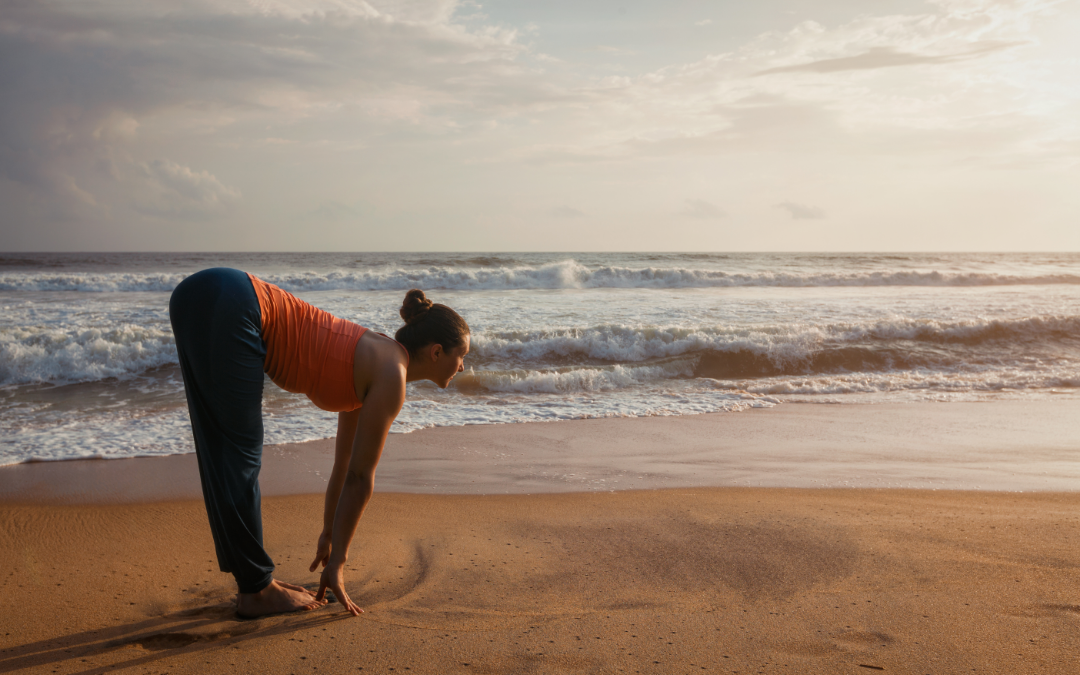Sun has been revered from time immemorial as both a source of vitality and spirituality. The significance of the sun can be traced from Indian, Egyptian, Mayan, Aztec, and Tibetan civilizations. Apart from the spiritual reasons, scientifically also life cannot sustain without the sun, being the source of heat on earth and has a range of effects on the human body.
Surya Namaskar or Sun Salutations involves 12 asanas which are performed in a particular sequence while chanting 12 different mantras. These mantras if chanted with serious gratitude can take the practice to an increased spiritual level. Surya Namaskar helps you warm, strengthen, and align your whole body.
Traditionally in Indian culture, the practice of Surya Namaskar was used to pay respects to the Sun, which is regarded as the source of life. The twelve postures also signify the 12 sun’s cycles which run at approximately twelve and a quarter years. Transitioning from one pose to another along with inhalation and exhalation, helps the practitioner develop harmony between our physical cycle and that of the sun.
Benefits of Surya Namaskar
- Helps you tone almost all your body parts including arms, thighs, belly, and hips.
- Makes you more flexible and improves your body posture.
- Improves your metabolism.
- Bring down your blood sugar levels.
- It’s a full-body workout. Doing Surya Namaskar for 30 minutes can help you burn 417 calories.
- Great cardio exercise and can help lose weight.
- Helps in regulating the menstrual cycle.
- Keeps various heart diseases at bay.
- Improves memory and functioning of the nervous system.
- Helps the body to get rid of carbon dioxide and other poisonous gases.
- Prevents hair loss and dandruff.
- Cultivates concentration and stillness of mind.
- Improves digestion and could help with indigestion, constipation, gas, and loss of appetite.
- Apart from physical benefits, Surya Namaskar has psychological benefits also such as memory retention, stress, anxiety, depression, and even insomnia.
- Enhances the size of the solar plexus, which in turn increases your creativity, decision-making, confidence, and leadership skills.
- Surya Namaskar can also be practiced by children which can help calm their minds, increase concentration, and also build endurance.
How to do Surya Namaskar?
Surya namaskar is done in three different speed variations – slow, medium, and fast. Slow-paced practice can help you become flexible, medium-paced will tone your muscles and improve blood circulation, and fast-paced is like a cardiovascular workout which can be helpful in weight loss. Practicing at a fast rate also helps in boosting metabolism.
Surya Namaskar is done in sets and one set consists of two rounds. If you are a beginner, start off with at least 6 sets or 12 rounds of Sun Salutations ( 6 with the right leg and six with the left leg). Let’s start with one round first.
1. Pranamasana or Prayer Pose
Mantra – Om Mitraaya Namaha
Meaning – One who is friendly to all
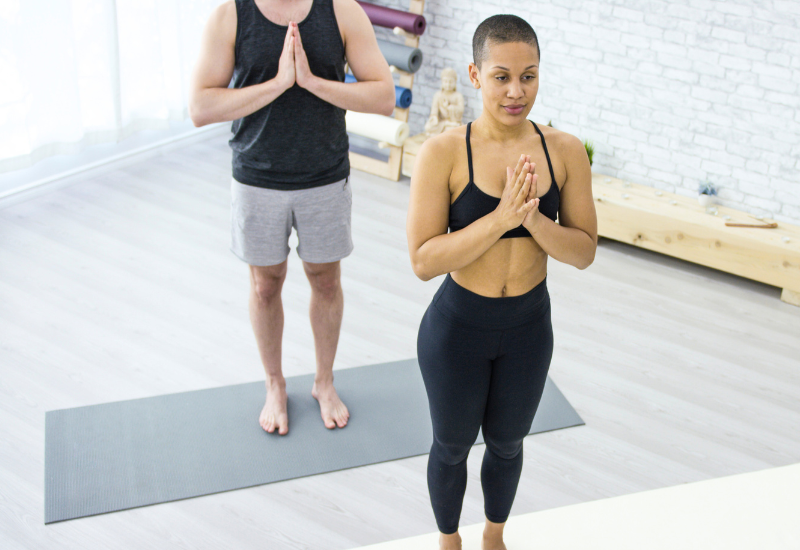
Instructions
Start by standing in Tadasana or Mountain pose at the top of the mat, joining your hands in prayer position. Open your chest and relax your shoulders. Close your eyes and try to connect with your breath.
Benefits
- Improves body balance and relaxes the nervous system.
- Mitigates stress and anxiety
2. Hasta Uttanasana or the Raised Hands Pose
Mantra – Om Ravaye Namaha
Meaning – The radiant one
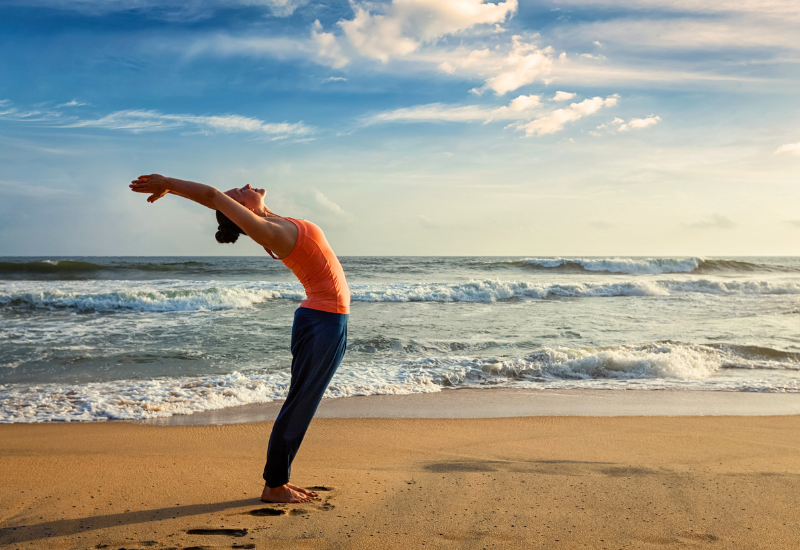
Instructions
Inhale and take your arms over your head and slightly bend backward by pushing your pelvis forward a bit. Extend your spine and stretch your whole body from the heels. Keep your shoulders back and down. For a deep stretch, instead of bending backward try to reach up with your fingers up.
Benefits
- Stretches and tones the abdominal muscles.
Aids digestion - Helpful for people suffering from lower back pain and fatigue
3. Hasta Padasana or Standing Forward Bend
Mantra – Om Suryaya Namaha
Meaning – One who dispels darkness
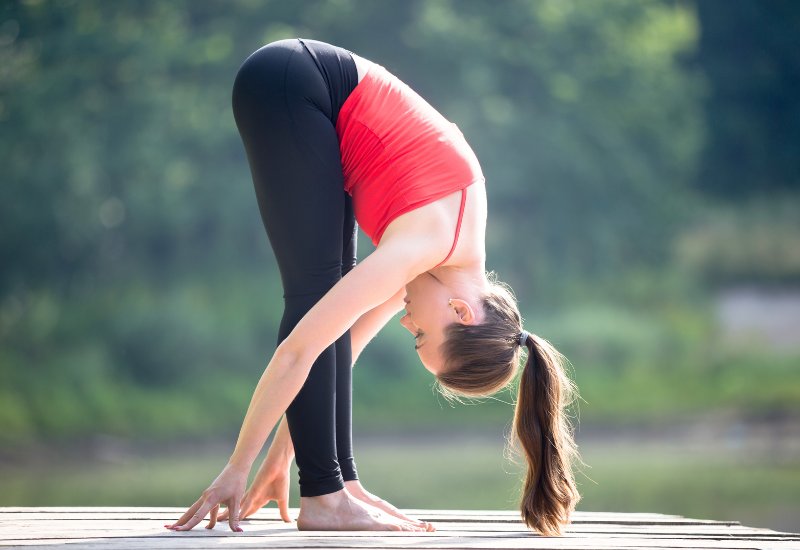
Instructions
Exhale, soften your knees and bend forward. Always bend from your pelvis or hips and not from the back. Engage your quads to open up your hamstrings. Try to touch your toes with your fingertips or press your palms on the mat.
Benefits
- Opens up the hamstrings
- Helps in curing stress, anxiety, headache, and insomnia.
4. AshwaSanchalanasana or Equestrian Pose
Mantra – Om Bhaanave Namaha
Meaning – One who illuminates

Instructions
Inhale, drop your left knee down. Keep you right leg at ninety degrees. Now take your left leg as far back as possible and shift the weight on your toes. Sink the hips and extend your spine. Ensure your right foot is exactly between your palms. Balance your body and look forward. Stay for a few breaths.
Benefits
- Stretches the thighs, and hip flexors
- Lengthens the spine
- Engages the quadriceps
- Relieves indigestion and constipation
5. Chaturanga Dandasana or Four Limbed Staff Pose
Mantra – Om Khagaya Namaha
Meaning – One who is all-pervading
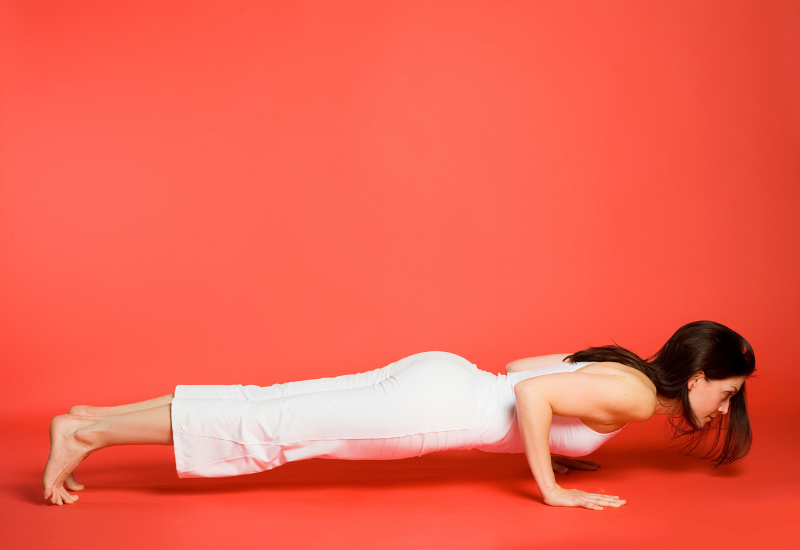
Instructions
Exhale and take your left leg back into plank pose. Keep your feet hip-distance apart and shoulders right over your wrist. Inhale, engage your core and bend your elbows straight back bringing them to the side of your body. Your elbows and wrists should be perpendicular to the floor. Keep your upper body and legs slightly above the floor and in a straight line. Look either down or straight ahead.
Benefits
- Improves the posture
- Stretches the arms, shoulder, chest, and spine.
- Builds the strength of your wrists, arms, and shoulders.
- Helps balance your blood sugar.
6. Ashtanga Namaskara or Knees, Chest, and Chin Pose
Mantra – Om Pooshne Namaha
Meaning – Giver of nourishment
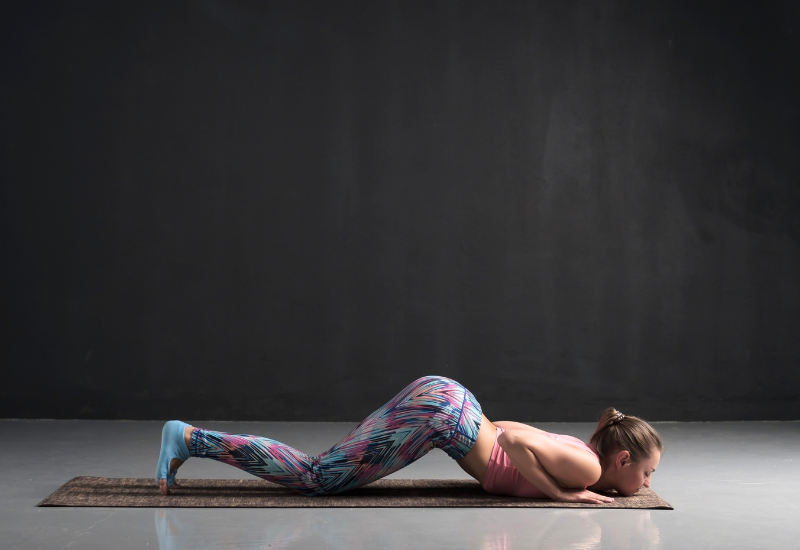
Instructions
Breathe out, drop your knees to the floor and bring your chin down. Your shoulders should be right over your hand and your elbows should be straight back touching your sides. Keep your hips raised.
Benefits
- Tones the abdominal area
- Enhances sense of balance
- Strengthens arms and wrists
- Improves the body’s overall posture
- The pose strengthens the arms, shoulders, and legs. It also releases the tension around the neck and shoulders and enhances the spine’s flexibility.
7. Bhujangasana or Cobra Pose
Mantra – Om Hiranya Garbhaya Namaha
Meaning – One who has golden colored brilliance

Instructions
Inhale, bring your body flat on the ground and place your palms close to the chest. Now, exhale and with the support of your hands slowly raise your chest from the floor followed by your upper back. Your pelvis should stay on the ground only. Keep your feet tucked in and gaze up or forward.
8. Parvatasana or the Mountain Pose
Mantra – Om Mareechaye Namaha
Meaning – One who gives light with infinite rays
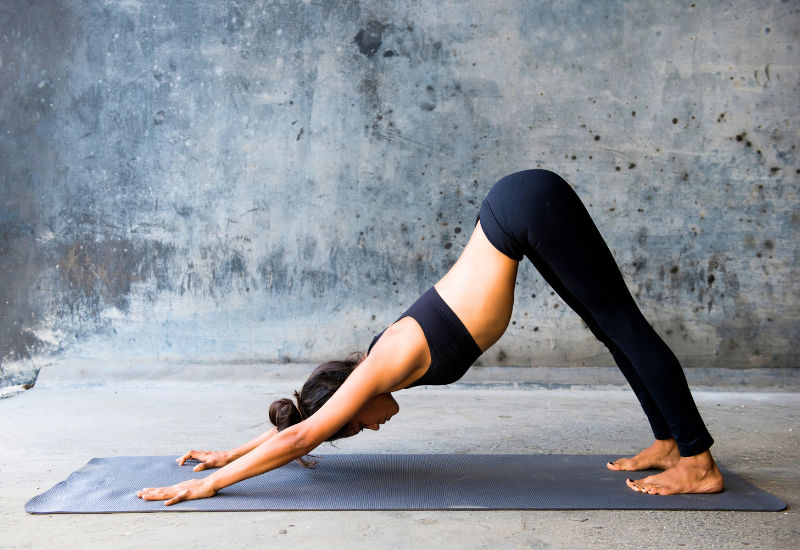
Instructions
Exhale, tuck your toes in, and lift your knees off the floor. Raise your buttocks and straighten your legs. Keep your arms activated and bring your heels down. Lift your tailbone up or as much as possible.
Benefits
-
Improves flexibility in the spine, hamstrings, and legs.
-
Strengthens the muscles of the shoulders, arms, and legs.
-
Improves the circulation of blood to the brain.
9. Ashwa Sanchalanasana or the Equestrian Pose
Mantra – Om Aadityaaya Namaha
Meaning – The son of Aditi, the cosmic divine mother

Instructions
Inhale, and bring the right foot forward between the two hands. Keep your left knee down on the floor. Push your hips down to the floor and now lookup.
10. Hasta Padasana or the Standing Forward Bend
Mantra – Om Savitre Namaha
Meaning – One who is responsible for life.

Instructions
Exhale, bring the left foot also forward, and keep your palms on the floor. Keep a slight bend in your knees, if necessary. If possible gently straighten your knees and touch your nose to the knees. Breathe normally.
11. Hasta Uttanasana or the Raised Hands Pose
Mantra – Om Arkaaya Namaha
Meaning – One who is worthy of glory and praise

Instructions
Inhale and take your arms up, palms pressing against each other, and bend backward a little bit. Keep your biceps close to your ears and push your hips slightly outward. You should try to stretch up more rather than stretching backward.
12. Pranamasana or the Prayer Pose
Mantra – Om Bhaskaraya Namaha
Meaning – Giver of cosmic illumination and wisdom.

Instructions
Exhale, straighten your body, and bring your arms down, your palms together in a prayer position in front of your chest. Relax in this position.
Tips
- The ideal time to practice Surya Namaskar is early in the morning facing the sun. In case you can’t do it in the morning, practice Surya Namaskar in the evening. Only make sure that you do it on an empty stomach. Practicing it in the morning energizes your body whereas it can help you unwind when performed at dusk.
- Surya Namaskar can also be accompanied by mantras that can bring peace, harmony in the mind, body, and soul. These mantras will add to the physical benefits of Surya Namaskar.
- While transitioning from one pose to another concentrate on your breathing.
- You shouldn’t practice if you had any recent surgeries, injuries and if you are pregnant. Always consult a medical professional before practicing Surya Namaskar.
- If you are a beginner you should do 2 to 4 rounds and gradually increase the number of cycles depending upon how comfortable your body gets with the poses.
- Inhale as you stretch or extend and exhale as you contract or fold.
- Finish the practice by doing Savasana or Corpse pose for 15 to 20 minutes.
The Takeaway
Just a few minutes of practicing Surya Namaskar can bring dramatic changes in the various aspects of your life. Surya Namaskar is a complete body workout that does not require any equipment. It is a perfect yoga sequence for those who don’t have much time for doing various yoga poses.
Spending 30 minutes every day five days a week is a good way to stretch, tone, and strengthen your muscles, joints, improve the flexibility of your spine, and the functioning of your internal vital organs. Moving slowly will calm you down while moving quickly is more stimulating. Whichever way you do it, just stay committed to your practice and do it regularly to achieve the best results.

